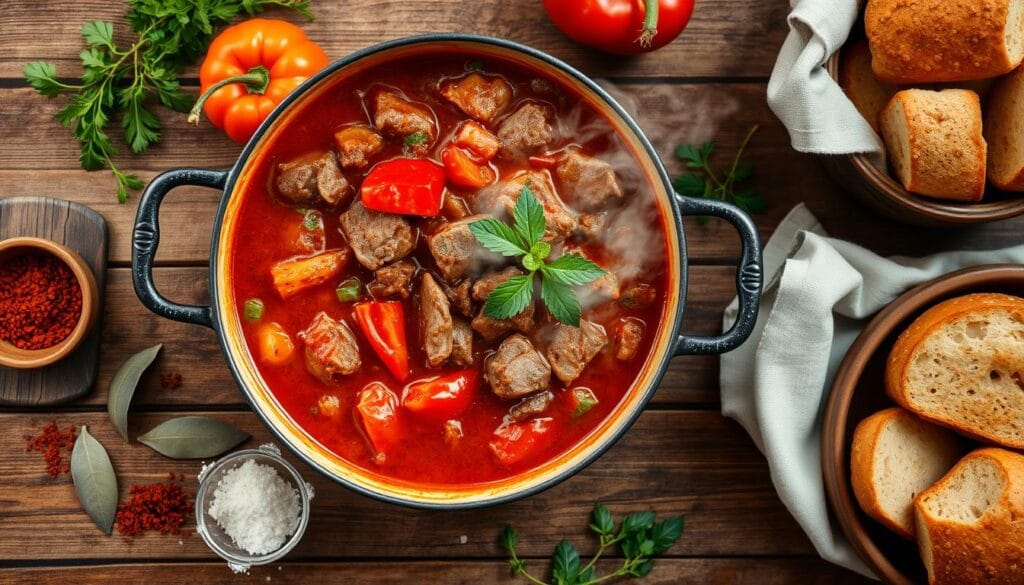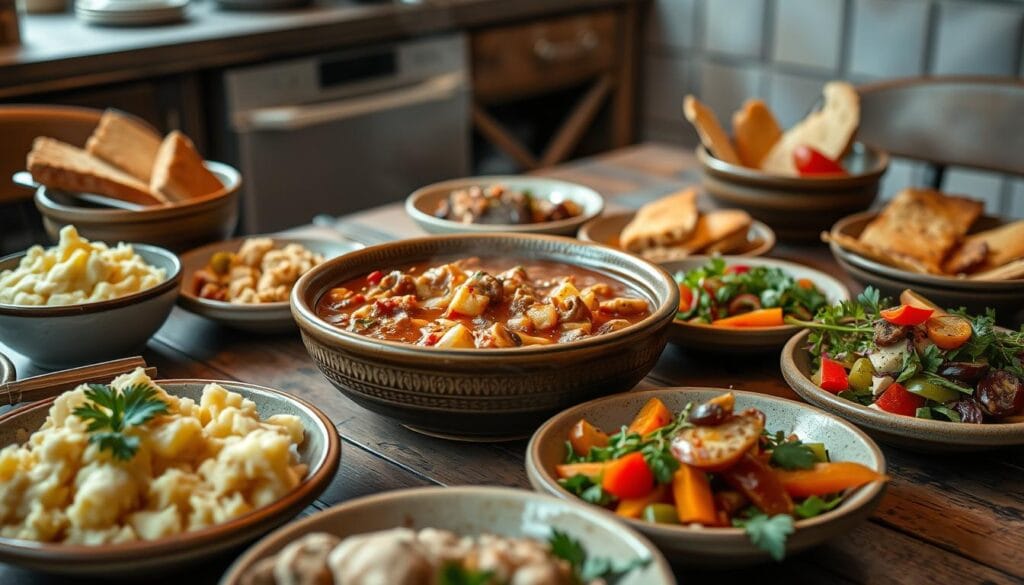Growing up, the smell of beef, paprika, and veggies filled our home on cold autumn days. It was my grandmother’s famous Hungarian goulash. This hearty stew was a family tradition, loved for generations in Hungary.
When I dipped homemade bread into the broth, I felt like a kid again. Sharing meals brought our family closer together.
If you love the taste of Hungarian goulash, you’re in the right spot. This guide will show you how to make traditional goulash at home. It doesn’t matter if you’re new to cooking or experienced. You’ll learn how to make a dish that will warm your heart and impress everyone.
Table of Contents
Key Takeaways
- Discover the rich history and cultural significance of authentic Hungarian goulash
- Learn the key ingredients and techniques for achieving the perfect balance of flavors in your homemade goulash
- Explore regional variations and unique twists on the classic traditional goulash recipe
- Mastering the art of slow-simmering for tender, flavorful beef
- Unlocking the secret to using the right amount of paprika for a truly authentic Hungarian goulash experience
What is Goulash?
Goulash, or “gulyás” in Hungarian, is a hearty stew from Hungary. It started as a simple meat and onion stew for shepherds. The addition of paprika in the 15th century by Ottoman Turks changed its flavor and color.
A Brief History of Goulash
Goulash has its roots in the 10th century. Hungarian shepherds made stews with what they had on the plains. Over time, it became the rich, slow-cooked stew we know today.
Key Ingredients in Goulash
- Beef: Traditionally, the dish was made with mutton or lamb, but modern goulash recipes typically use beef as the main protein.
- Onions: Onions are a crucial component, providing the foundation for the stew’s flavor.
- Paprika: The introduction of this spice, often in both sweet and smoked varieties, gives goulash its signature red hue and distinctive taste.
- Tomatoes: Diced tomatoes or tomato sauce add acidity and body to the stew.
- Bell Peppers: These vegetables can add a subtle sweetness and color to the dish.
- Carrots and Potatoes: These root vegetables are common additions, providing substance and texture.
Regional Variations of Goulash
While traditional Hungarian cuisine goulash stays the same, there are many regional twists. Recipes might include wine, caraway seeds, or different veggies. In Hungary today, it’s mostly a soup called gulyásleves.
In the former Austrian-Hungarian Empire, goulash is loved in many ways. It’s often served with potatoes, polenta, dumplings, spätzle, or bread. In the Czech Republic and Slovakia, it’s beef-based and served with bread dumplings, best with a cold beer.
Essential Tools for Cooking Goulash
To make a delicious Hungarian goulash at home, you need the right tools. Make sure you have the essential items for your kitchen.
Recommended Cookware
A Dutch oven is perfect for goulash. It keeps heat and moisture in, blending flavors well. Look for the Lodge 6-quart Dutch oven or the Le Creuset for top quality.
Useful Kitchen Gadgets
- A sharp chef’s knife for easy veggie chopping
- A sturdy wooden spoon for stirring the goulash
- Measuring cups and spoons for exact ingredient amounts
- A reliable cutting board and a vegetable peeler for prep
With these goulash cooking tools and kitchen equipment, you’re ready to make a tasty Hungarian goulash at home.
Preparing the Ingredients for Goulash
Making a true Hungarian goulash needs careful ingredient prep. Choosing the right goulash meat and chopping the vegetables right is key. Each step is important for the dish’s flavor and texture.
Selecting Quality Meat
Choose tougher beef cuts for the best goulash. Good options are shank, top round, bottom roast, or sirloin. These cuts get tender and delicious with long cooking.
Chopping Vegetables Strategically
- Onions: Chop into uniform, bite-sized pieces for even cooking.
- Bell Peppers: Prefer a mix of red and yellow peppers, diced into similar-sized chunks.
- Tomatoes: Dice fresh, ripe tomatoes to release their juices and enhance the goulash’s flavor.
- Carrots: Peel and slice the carrots into rounds or half-moons for a consistent texture.
- Potatoes: Cube the potatoes to ensure they cook through alongside the other ingredients.
For spices, use genuine Hungarian sweet paprika for the best taste. Some recipes also add bacon for extra richness.
Good ingredient preparation is the base of a traditional Hungarian goulash. By picking quality meats and chopping veggies carefully, you’ll make a dish that will please your taste buds.
“The secret to a great goulash lies in the meticulous preparation of the ingredients. Each step, from selecting the right meat to chopping the vegetables with precision, contributes to the final, mouthwatering result.”
The Traditional Goulash Recipe
Goulash is a beloved Hungarian dish known for its hearty and flavorful stew. It has won the hearts of home cooks around the world. Follow this guide to make the traditional authentic goulash recipe in your kitchen.
Step-by-Step Cooking Instructions
- Start by browning thick-cut bacon or lard in a large pot over medium-high heat. Remove the bacon once the fat is rendered.
- Put the diced onions in the pot and cook until they’re golden brown, about 8-10 minutes.
- Add the cubed beef chuck to the pot and brown it on all sides for a nice sear.
- Minced garlic goes into the pot next, cooking for a minute until it’s fragrant.
- Then, add the diced bell peppers and tomatoes, along with goulash seasoning like paprika, cumin, and caraway seeds.
- Use red wine to deglaze the pot, scraping up browned bits from the bottom.
- Pour in beef broth and bay leaves. Simmer on low for about 90 minutes, until the meat is tender.
- Finally, add diced potatoes and carrots. Cook for another 20-25 minutes, until they’re tender.
Tips for Proper Seasoning
For authentic cooking goulash, use plenty of paprika – at least 1/4 cup of Hungarian sweet paprika. This gives your goulash its signature red color and smoky flavor. Adjust salt and pepper to taste, but be careful not to over-season. The key is to let the flavors meld during the long simmer.

“The secret to a truly authentic goulash is in the paprika. Use the best quality Hungarian sweet paprika you can find, and don’t be afraid to be generous with it.”
With these instructions and seasoning tips, you’ll make a cooking goulash that feels like a trip to Hungary. Enjoy your homemade, authentic goulash recipe with family and friends.
Common Mistakes to Avoid When Making Goulash
Making the perfect goulash needs careful attention and knowledge of common mistakes. As you start making goulash, avoid these common errors to get a delicious, authentic dish.
Overcooking the Meat
One big mistake in making goulash is overcooking the meat. Using the wrong beef can make it tough and dry instead of tender. Use chuck, which gets tender when cooked slowly.
Make sure to sear the beef in batches before adding it to the stew. This step adds a rich flavor that’s hard to get otherwise.
Neglecting Spice Balance
Goulash’s success comes from the right mix of spices. Not using enough paprika is a big mistake. Use high-quality Hungarian paprika but don’t burn it when adding it to the pot.
Also, balance the cumin, caraway, and paprika to your liking. Don’t rush the cooking. Let the goulash simmer until the flavors blend together perfectly.
By avoiding these mistakes and following the best practices, you’ll make a goulash that would impress any Hungarian grandma. The secret to a perfect goulash is in the details and patience to let it simmer and develop its flavors.
Serving Suggestions for Goulash
Make your goulash meal better by choosing the right side dishes and drinks. This hearty stew needs sides that soak up its rich broth and match its tender meat.
Best Side Dishes to Complement Goulash
There are many tasty side dishes that go well with goulash. From classic Hungarian dishes to modern options, here are some:
- Crusty bread or rolls to soak up the goulash broth
- Creamy mashed potatoes or fluffy rice to balance the stew
- Steamed or roasted vegetables like carrots, green beans, or cabbage
- Tangy cucumber salad or pickles to cut through the richness
- Savory spaetzle, a traditional German-style dumpling
- Nutty quinoa or brown rice for a healthier, low-carb option
Ideal Pairings with Drinks
Choose the right drinks to go with your goulash:
- Hungarian red wines like Egri Bikavér or Villányi Kékfrankos, which complement the bold flavors
- Czech or Hungarian lager beers, which offer a refreshing contrast to the hearty stew
- A dollop of sour cream on top, which adds a creamy, tangy element
For an authentic touch, serve the goulash in traditional Hungarian-style bowls. This will make your meal feel more like a real Hungarian experience.

“Goulash is a dish that demands to be savored, and the right side dishes and drinks can elevate it to new heights of deliciousness.”
Storing and Reheating Goulash
After enjoying your homemade goulash, you’ll want to keep it fresh. Proper storage and reheating are key to keeping its taste. These steps help you enjoy your goulash for days.
Proper Storage Techniques
Store your goulash in an airtight container in the fridge for up to 5 days. For longer storage, freeze it for up to 3 months. Cool the goulash before freezing it in a freezer-safe container or bag.
Tips for Reheating Without Losing Flavor
To reheat your goulash, use gentle heat. On the stovetop, add beef broth and heat it over low, stirring often. This keeps the flavors rich and savory.
For microwaving, heat in short intervals of 2-3 minutes, stirring between. Let it rest for a minute to even out the flavors. This method can dry out the dish if not done right.
Whether stovetop or microwave, reheat slowly to avoid losing the goulash’s texture and taste. With care, your leftover goulash will taste as good as the first time.
Goulash Variations to Try
There’s more to goulash than the traditional Hungarian dish. You can find many exciting variations to try at home. Whether you love meat or prefer plant-based options, there’s a goulash recipe for you.
Vegetarian and Vegan Goulash Options
Goulash doesn’t have to be just about beef or pork. You can make vegetarian or vegan versions that are just as tasty. Use mushrooms, lentils, or plant-based meats like soy or tempeh instead. For a dairy-free version, skip the sour cream or use cashew cream instead.
Unique Ingredients to Elevate Your Goulash
Try adding unique ingredients to your goulash for more flavor. Use root vegetables like parsnips, turnips, or celeriac for a twist. Adding a bit of red wine to the broth can also enhance the taste.
Don’t forget to explore different regional goulash recipes. For example, the Székely gulyás from Hungary includes sauerkraut. The bean-based babgulyás is another interesting variation. These regional dishes show how diverse goulash can be.
| Goulash Variation | Key Ingredients | Cooking Time |
|---|---|---|
| Vegetarian Goulash | Mushrooms, lentils, or plant-based meat alternatives | 30 minutes |
| Vegan Goulash | Mushrooms, lentils, or plant-based meat alternatives, cashew cream | 30 minutes |
| Székely Gulyás | Beef, paprika, sauerkraut | 45 minutes |
| Babgulyás | Beans, paprika, tomatoes | 1 hour |
Whether you’re in the mood for a classic Hungarian goulash or something new, there’s a lot to try. Get creative and explore these goulash variations for a unique dining experience.
Frequently Asked Questions About Goulash
Common Queries and Expert Answers
Exploring traditional Hungarian goulash can raise some questions. Don’t worry, we’ve got answers to the most common ones. These will help you on your goulash-making journey.
Many wonder about the difference between goulash and beef stew. Both have beef and veggies, but goulash uses more paprika. This gives it a unique color and taste. Beef stew, on the other hand, has a tomato-based sauce. Goulash is simmered longer to blend flavors better.
Choosing the right beef for goulash is another common question. Experts suggest using tougher cuts like shanks, sirloin, or chuck. These cuts get tender and flavorful after simmering. It’s also important to adjust the liquid to get the right consistency.
Tips for Customizing Your Recipe
Once you know the traditional recipe, feel free to add your own twist. You can adjust the spices or add unique ingredients like bell peppers or mushrooms. Remember, using high-quality Hungarian paprika is key to a great goulash.
Goulash is all about being adaptable. You can make it thicker like a stew or thinner like a soup. With a few tweaks, you can create a goulash that suits your taste. So, go ahead and make it your own.
FAQ
What is the difference between goulash and beef stew?
Goulash and beef stew differ mainly in spices and cooking methods. Goulash, a Hungarian dish, relies heavily on paprika. Beef stew, on the other hand, uses a mix of herbs and seasonings. Goulash is often cooked in a bogracs, a heavy iron kettle, while beef stew is made in a Dutch oven or pot.
What are the best cuts of beef to use for goulash?
For authentic goulash, choose tougher, cheaper cuts of beef. These include shank, top round, bottom roast, or sirloin. They tenderize well with long cooking times.
How can I achieve the right consistency for my goulash?
To get the right consistency, simmer the goulash slowly. Adjust the liquid as needed. Avoid overcooking the meat to keep it tender. Use plenty of paprika to enrich the broth.
Can I make a vegetarian or vegan version of goulash?
Yes, you can make vegetarian or vegan goulash. Use mushrooms, lentils, or plant-based meat alternatives instead of beef. For vegan versions, skip the sour cream or use a plant-based substitute. Try adding parsnips, turnips, or celeriac for extra flavor.
What are some common variations of goulash?
There are many variations of goulash. Székely gulyás adds sauerkraut, while babgulyás includes beans. You can also add red wine for flavor or try different vegetables like parsnips or turnips.
How do I customize my goulash recipe?
To customize your goulash, adjust the spice levels. Add more or less paprika, cumin, and caraway seeds. Experiment with vegetables like parsnips or turnips. Try regional variations for a unique twist.

